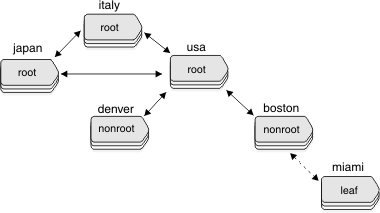Hierarchy Example
This example adds a replication tree to the fully-connected environment of the usa, italy, and japan replication servers.

To try this example, you need to prepare three additional database servers: boston, denver, and miami. To prepare the database servers, use the techniques described in Replication Example Environment.
The following example defines a replication hierarchy that includes denver, boston, and miami and, whose root is usa.
To define a hierarchy
- Add boston to the replication hierarchy as a nonroot server
attached to the root server usa:
cdr define server --connect=boston --nonroot --init \ --sync g_usa g_bostonThe backslash (\) indicates that the command continues on the next line.
- Add denver to the replication hierarchy as a nonroot server
attached to the root server usa:
cdr define server -c denver -I -N --ats=/ix/myats \ -S g_usa g_denverThis command uses short forms for the connect, init, and sync options. (For information about the short forms, refer to Option Abbreviations.) The command also specifies a directory for collecting information about failed replication transactions, /ix/myats.
- List the replication servers as seen by the usa replication
server:
cdr list serverThe root server usa is fully connected to all the other root servers. Therefore usa knows the connection status of all other root servers and of its two child servers, denver and boston. The command returns the following information:
SERVER ID STATE STATUS QUEUE CONNECTION CHANGED ----------------------------------------------------------- g_boston 3 Active Connected 0 Aug 19 14:20:03 2000 g_denver 27 Active Connected 0 Aug 19 14:20:03 2000 g_italy 8 Active Connected 0 Aug 19 14:20:03 2000 g_japan 6 Active Connected 0 Aug 19 14:20:03 2000 g_usa 1 Active Local 0 - List the replication servers as seen by the denver replication
server:
cdr list server --connect=denverThe nonroot server denver has a complete global catalog of replication information, so it knows all the other servers in its replication system. However, denver knows the connection status only of itself and its parent, usa.
The command returns the following information:
SERVER ID STATE STATUS QUEUE CONNECTION CHANGED ----------------------------------------------------------- g_boston 3 Active 0 g_denver 27 Active Local 0 g_italy 8 Active 0 g_japan 6 Active 0 g_usa 1 Active Connected 0 Aug 19 14:20:03 2000 - Define miami as a leaf server whose parent is boston:
cdr define server -c miami -I --leaf -S g_boston g_miami - List the replication servers as seen by miami:
cdr list server -c miamiAs a leaf replication server, miami has a limited catalog of replication information. It knows only about itself and its parent.
The command returns the following information:
SERVER ID STATE STATUS QUEUE CONNECTION CHANGED ----------------------------------------------------------- g_boston 3 Active Connected 0 Aug19 14:35:17 2000 g_miami 4 Active Local 0 - List details about the usa replication server:
cdr list server g_usaThe server is a hub; that is, it forwards replication information to and from other servers. It uses the default values for idle timeout, send queue, receive queue, and ATS directory.
The command returns the following information:
NAME ID ATTRIBUTES -------------------------------------------------------------- g_usa 1 timeout=15 hub sendq=rootdbs recvq=rootdbs atsdir=/tmp